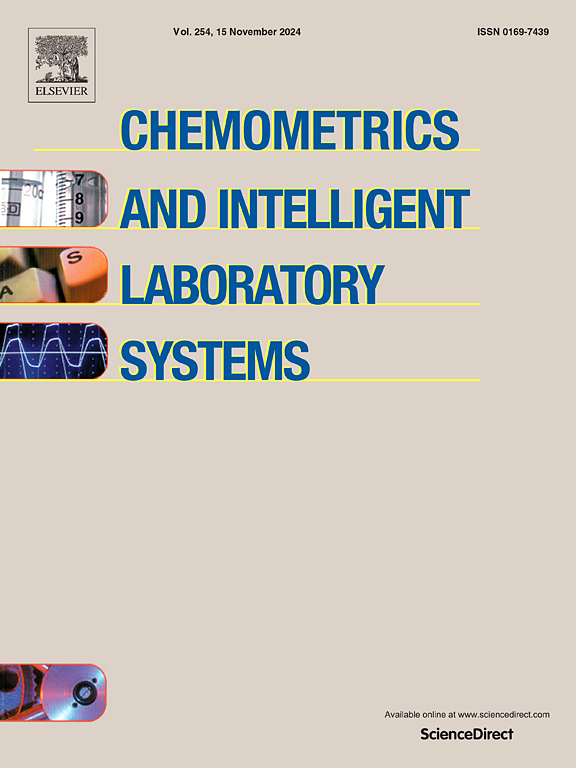Classification of aluminum alloy using laser-induced breakdown spectroscopy combined with discriminative restricted Boltzmann machine
IF 3.7
2区 化学
Q2 AUTOMATION & CONTROL SYSTEMS
Chemometrics and Intelligent Laboratory Systems
Pub Date : 2025-02-04
DOI:10.1016/j.chemolab.2025.105342
引用次数: 0
Abstract
Laser-Induced Breakdown Spectroscopy (LIBS), combined with modern machine learning tools, has emerged as a powerful technique for metal material identification, leveraging its high sensitivity and rapid response. However, the current spectral data analysis methods typically involve a two-step process of dimensionality reduction and model learning, lacking seamless integration. In this study, we address this issue by investigating a discriminative learning approach based on LIBS, utilizing the Discriminative Restricted Boltzmann Machine (DRBM). We apply LIBS technology in conjunction with DRBM for spectral feature selection and classification of five distinct small-sample aluminum alloy samples. The learned spectral latent distribution from the generative model component of DRBM effectively regularizes the discriminative process, thereby overcoming the problem of training overfitting arising from the high-dimensional small-sample limitation. This results in a stable and generalizable qualitative analysis model independent of empirical knowledge. The approach presented in this study achieves a 100 % accuracy, surpassing the best-performing traditional machine learning method (PCA-RF) by 13.33 % in accuracy and demonstrating a similar improvement compared to a Backpropagation Neural Network (BPNN) with the same structure.
激光诱导击穿光谱结合判别受限玻尔兹曼机对铝合金进行分类
激光诱导击穿光谱(LIBS)与现代机器学习工具相结合,凭借其高灵敏度和快速响应能力,已成为金属材料识别的一种强大技术。然而,目前的光谱数据分析方法通常涉及降维和模型学习两步过程,缺乏无缝集成。在这项研究中,我们通过研究一种基于LIBS的判别学习方法来解决这个问题,该方法利用了判别受限玻尔兹曼机(DRBM)。我们将LIBS技术与DRBM相结合,对五种不同的小样本铝合金样品进行光谱特征选择和分类。从DRBM的生成模型成分中学习到的谱潜分布有效地正则化了判别过程,从而克服了高维小样本限制引起的训练过拟合问题。这导致了一个稳定的和可推广的定性分析模型独立于经验知识。本研究中提出的方法实现了100%的准确率,在准确率上超过了性能最好的传统机器学习方法(PCA-RF) 13.33%,并且与具有相同结构的反向传播神经网络(BPNN)相比,显示了类似的改进。
本文章由计算机程序翻译,如有差异,请以英文原文为准。
求助全文
约1分钟内获得全文
求助全文
来源期刊
CiteScore
7.50
自引率
7.70%
发文量
169
审稿时长
3.4 months
期刊介绍:
Chemometrics and Intelligent Laboratory Systems publishes original research papers, short communications, reviews, tutorials and Original Software Publications reporting on development of novel statistical, mathematical, or computer techniques in Chemistry and related disciplines.
Chemometrics is the chemical discipline that uses mathematical and statistical methods to design or select optimal procedures and experiments, and to provide maximum chemical information by analysing chemical data.
The journal deals with the following topics:
1) Development of new statistical, mathematical and chemometrical methods for Chemistry and related fields (Environmental Chemistry, Biochemistry, Toxicology, System Biology, -Omics, etc.)
2) Novel applications of chemometrics to all branches of Chemistry and related fields (typical domains of interest are: process data analysis, experimental design, data mining, signal processing, supervised modelling, decision making, robust statistics, mixture analysis, multivariate calibration etc.) Routine applications of established chemometrical techniques will not be considered.
3) Development of new software that provides novel tools or truly advances the use of chemometrical methods.
4) Well characterized data sets to test performance for the new methods and software.
The journal complies with International Committee of Medical Journal Editors'' Uniform requirements for manuscripts.

 求助内容:
求助内容: 应助结果提醒方式:
应助结果提醒方式:


